Best road bikes under $1000: our pick of the bunch in 2024
You can still find some great road bikes that won't break the $1000 barrier


The best road bikes under $1000 still offer great value for money. Bike prices have continued to increase over the last few years, but there are still bikes to be found that hit this price point.
On this page, you'll find our four-up $1000 test, as well as a selection of bikes we've tested individually, and recommend.
Best road bikes under $1000
You can trust Cycling Weekly.
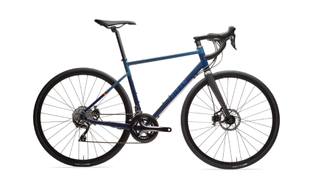
1. Triban 520 road bike
Specifications
Reasons to buy
Reasons to avoid
Rebranded and redesigned, the aluminium frame now comes with a carbon bladed fork. The Triban 520 has also switched to disc brakes in the form of TRP's well regarded HY/RD mechanical offerings. And amazingly, for a bike of this price, you also get Shimano 105.
The frame's geometry places the 520 clearly in the endurance/commuter/light tourer camp. Think generous stack height and shorter top tube. If you're looking to get 'long and low' then this probably isn't the bike for you. However, if you favour comfort and stability over speed and need a bike that can handle the trifecta mentioned above then the 520 is well worth further consideration.
Its credentials as a solid all-rounder are deepened by both the tyre clearance and the rack and mudguard mounts. The bike comes equipped with 28mm tyres. However there's room for up to 36mm of rubber should you want to hit the bridleways or dirt roads or fancy attempting an audax ride or two when comfort is paramount. Add guards (fenders) and a pannier rack and the 520 is ready for daily commute duties or some multi-day touring. Versatile indeed.
As mentioned earlier the bike's greatest asset might just be that 105 groupset. However it's worth noting that this isn't a full 105 set-up. To help keep costs down Decathlon has opted for a Shimano RS510 chainset and a Microshift cassette. While they'll add a little weight they shouldn't adversely affect performance. As for the gearing you get a compact 50/34t chainset paired with an 11-32t cassette. The result is a decently low gear that helps negate some of the bike's weight when climbing the steep stuff.
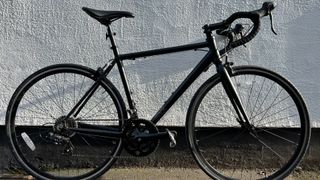
Specifications
Reasons to buy
Reasons to avoid
An in-house offering from Wiggle/Chain Reaction, the Brand X road bike offers impressive value.
Gearing comes from a 2x7-speed Shimano Tourney groupset with a 50/34t Prowheel chainset and 14-28t freewheel (rather than a more modern cassette). Although this gives limited high and low end gearing and quite large jumps between gears, it's still great to see a Shimano groupset and combined brake/shifter levers on a bike at this price.
As you might expect, the Brand X road bike is fitted out with rim brakes rather than the more expensive disc brake calipers. Cables are also external rather than running through the frame or boasting full outers, so they may be more prone to contamination. This isn't an unusual feature in a lower priced bike though. The nominally 25mm Kenda tyres measure closer to 23mm. At 11.4kg, the Brand X isn't too heavy either.
There are even mudguard and rack mounts if you want to use the Brand X road bike for commuting or all-weather duties.
Read more: Brand X road bike full review
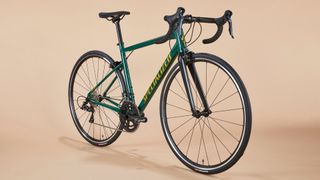
Specifications
Reasons to buy
Reasons to avoid
The Allez bike range from Specialized is one of the best selling bikes in the industry, and at last review we awarded this model a near perfect 4.5 stars. The Allez Sport is in the middle of the three bike range.
Designed with 'balanced' geometry, its ride position is comfortable enough but you can slam the stem for a more aggressive ride. In fact this is a bike that's versatile enough to handle a fast club run, a commute to work and plenty of winter miles too, although we found the ride a little harsh.
The aluminium frame features the brand's 'SmoothWeld' tech keeping the joins neat. The dropped stays and internal cable routing give it a contemporary 'race' look while the stack height and chainstay length point more towards comfort and stability - which makes a great deal of sense for any entry-level road bike. On review we found the Allez Sport inspired confidence thanks to its assured handling.
The carbon FACT fork helps to smooth out the ride while also helping to reduce weight - the Allez tips the scales at just over 9kg. The fork also features mudguard eyelets, helping further add to the bike's commuter and four-season credentials.
Elsewhere you have Shimano's tried-and-tested 9-speed Sora groupset sitting in a threaded bottom bracket shell. The compact chainset is paired with an 11-32t cassette, which provides a nice wide range. Tackling steep climbs and rolling quickly along the flats are both achievable here.
At this price point there are always compromises and on the Allez Sport these come in the form of the own-brand Axis 1.0 rim brakes. On review we found their performance to be lacklustre and took downhills carefully. That said, the brake pads or even the entire callipers can be easily upgraded and it's a change that the superb Allez frameset warrants.
Read more: Specialized Allez Sport full review

4. Diamondback Haanjo 2
Specifications
Reasons to buy
Reasons to avoid
A recommendation from one of our trusted US testers, the Diamondback Haanjo offers something a little different when compared with the pure road bikes in this list.
Being a gravel/adventure bike, the Haanjo will roll smoothly on the road but also comes with 38c tyres (or, tires) which will cushion out the bumps for off-road gravel rides.
In fact versatility is a constant theme with the Haanjo. The frameset, made from fully butted 6061 aluminium, features front and rear rack mounts as well as mudguard, (or fender) eyelets. This makes it well suited for light touring, commuting and winter training rides. This versatility is reflected in the generous stack height, the slack-ish headtube angle and the long chainstays, all of which point to a stable and comfortable ride.
The wide tyres and more rugged frame - with a steel fork - do naturally boost the weight but the Haanjo comes with a sub-compact 46/34t chainset and an 8-speed 11-32t cassette to help you get up the steeper climbs. Shifting comes courtesy of Shimano Claris while stopping is left to Tektro and its flat-mount mechanical disc brakes. By using the newer flat mount standard Diamondback has made it straightforward to upgrade the brakes if required.
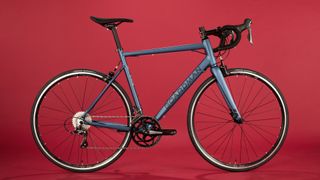
Specifications
Reasons to buy
Reasons to avoid
The Boardman SLR 8.6 is the brand's base model, but despite this its alloy frame has smoothed welds on the main tubes, almost giving it the look of carbon. The fork really is carbon.
Like the Pinnacle, there's a Shimano Claris groupset with the same gear ratios and Tektro rim brakes. Both have their deficiencies relative to more expensive options: the large jumps in gear ratios and the indifferent braking respectively.
But we were impressed by the frame's efficiency and the quite racy geometry, although there's a bit of road buzz on less smooth surfaces. The Boardman own-brand components work well and are comfortable. Boardman's wheels are tubeless ready if you want to upgrade the tyres.
Read more: Boardman SLR 8.6 full review
$1000 grouptest
Braking: cable discs v rim brakes
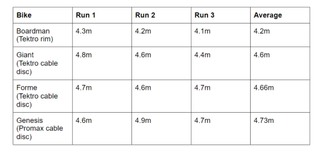
$1000 grouptest
Whilst elsewhere in the industry, specification sheets read a little more like a game of price point bingo, in the $1000 classification the choice of componentry varies dramatically.
Our group test includes four options, one with a carbon frame, three opting for aluminium. Groupsets range from Shimano Claris, to Shimano Tiagra, right up to Shimano 105 and whilst three bikes use cable-actuated disc brakes, one forgoes these for the more traditional rim. All of these factors affect the weight - with these ranging from 19lbs / 8.75 kilograms to 22lbs / 10.85kg.
We tested all of the bikes with the tires specced as standard, since that’s the rubber most consumers will use for the first year or so, as well as a control tyre. But, since tyres are the interface between the rider and the road, and do significantly affect ride quality, we’ve tested each bike with a pair of Schwalbe Pro One TLE tyres in a 25mm tire size, too.
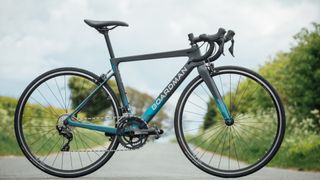
The Boardman SLR 8.9 was the test winner
Specifications
Reasons to buy
Reasons to avoid
The Boardman SLR 8.9 was our test winner. It's available in men's and women's builds, the difference being the handlebar width, stem length and choice of saddle.
Yes, it's a little over budget. But the SLR 8.9 was the only carbon bike on test. It comes with rim brakes, but we found these to be more effective than the cable-actuated discs elsewhere. The use of Shimano 105 shifters and derailleurs brings 11-speed gearing, which represents a huge improvement over the 8-speed elsewhere.
At 19lbs / 8.75kg, the Boardman SLR 8.9 was significantly lighter than the other three bikes on test, which were all over 22lbs / 10kg. Not only that, thanks to Boardman's decision to build a wind tunnel (which it has since sold), the frame has been aero optimised.
The geometry is more aggressive than most at this price point, with a shorter headtube, though the reach isn't back achingly long at all. This is a bike you could easily upgrade over time, add a pair of the best road bike wheels and it would look at home on the start line of a race.
Our size small has a slack head angle, at 70.5 degrees. This is to avoid toe overlap, larger sizes come with angles closer to 72 degrees. It's a shame that this isn't possible on the smaller bikes, but the handling didn't feel slow on test at all.
The max tire width is 28mm, which could put off those looking for more squish.

Specifications
Reasons to buy
Reasons to avoid
The Genesis CDA is the aluminium version of the British brand’s steel Croix de Fer, the bike Vin Cox rode to the round-the-world record in 2020. This bike is all about versatility, it promises to carry you comfortably on the road, gravel, and with 24 mounts is well set up to be a competent tourer or bikepacking bike.
With its steel fork, the Genesis is not lightweight at all, but it bombs along extremely comfortably. Whilst it might not be a race winner, if you want to disappear on an all-day adventure and enjoy every pedal stroke, this is one to consider.
The groupset is a mixture of Shimano Tiagra and GRX, it's 10-speed and uses a Shimano Hollowtech II bottom bracket. The bars are flared and as standard the tyres are 37c WTB Riddler Comp, they'll provide plenty of assurance off-road, though if you plan to stick to tarmac we'd recommend swapping them.
The skewers are quick release, instead of thru-axles often adopted on disc brake bikes, but we didn't notice any excessive flex as a result.
The wheelbase is long, creating a stable ride. The only major downside to this bike is the brakes - this was the slowest stopping bike. A brake pad upgrade could help, but if at all possible we recommend saving up for a hydraulic disc brake version, especially if you plan to load the bike up with bikepacking gear.
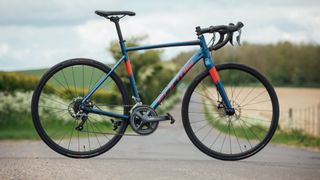
Forme Monyash 2
Our expert review:
Specifications
Reasons to buy
Reasons to avoid
Our full review of the Monyash 2 from Forme is yet to be published - this is a brand new addition to the market, but rest assured it's been thoroughly tested.
The Monyash was previously Forme's gravel bike, but this version has been redesigned to focus more on the road, though with clearance for 32mm tires it's still a machine you could convert for the trails if you want to. The standard tires are 28mm Schwalbe One.
The Monyash has been given a geometry update, with a longer and lower stack and reach, and a 74 degree seat angle to bring the rider over the bottom bracket. Whilst it's more relaxed than a race bike, with a long wheelbase to aid stability, our tester had no issues getting into a position which suited a fast paced club run.
This is the cheapest bike on test. It comes with Shimano Claris 8-speed shifting, but unlike the Giant (also Claris) uses a matching crankset and Shimano Hollowtech II bottom bracket - representing a stiffness boost on the more expensive competition.
The Tektro mechanical discs didn't impress us much but were in line with disc brake performance at this price point.
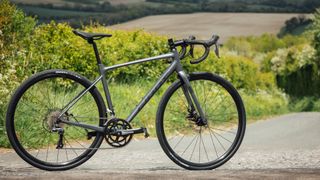
Specifications
Reasons to buy
Reasons to avoid
Giant produces the Contend at many different price points, in this case with have an aluminium frame, carbon fork and cable disc brakes for around $1000.
The frame can accommodate tires as wide as 40mm, and in this case it comes specced with Giant's own 32mm rubber. These tyres could easily handle rutted roads, gravel and light off-road tracks.
The Giant's ride is harsher than that of the Boardman, by nature of being aluminium. It does use a d-shaped seatpost, which aims to disrupt vibration, and whilst we're sure this has some effect it's still not a plush ride.
The groupset is Claris, which is 8-speed, and in this case Giant has specced an FSA chainset and a square taper bottom bracket, these are easier to maintain but can feel a bit flexy when getting out of the saddle.
The geometry is upright and relaxed, though a 71.8 degree head angle yields snappy enough handling. Being cable-actuated Tektro brakes, the stopping power is much the same as on the Forme.
Verdict
There can be absolutely no doubt as to the winner of this test: with its significantly lower weight, 11-speed shifting and, according to our experiments, more responsive braking the Boardman SLR 8.9 is a clear champion.
The carbon frame creates a ride that’s both stiffer and more compliant than the competition. Compared to the other bikes on test, the Boardman puts the rider in a more aggressive position, with a lower stack and a reach that could be racy with a longer stem. It’s pleasing to see that Boardman specs this frame with both touch points suited to men and women, too, so female riders who more often than not require narrower bars won’t have to swap these straight out of the box.
The Boardman SLR 8.9 is race proven, and with a few upgrades here and there - a deep set of carbon wheels and a carbon seat post, for example, it could journey with a cyclist from their first ride, to their first sportive, and on to their first number pinning experience.
Of course, not everyone is seeking a bike that would fit in well at the start line of a criterium race as well as a club run or sportive. If you’re seeking all-day comfort, we thoroughly recommend the Genesis CDA 30 for the bomb-along ride quality and comfort of that steel fork. This is a bike that promotes the joy of just pedalling, all day if rider inclination calls for it. The carrying capacity is impressive, too, though we worry about loading up the weight based upon the performance of the brakes. A brake pad upgrade could make all the difference.
The Forme Monyash 2 and Giant Contend AR 4 are similar to each other in specification, though the Monyash comes in around $100 cheaper and also has the benefit of a matching chainset and stiffer bottom bracket. They’re both versatile and fun to ride machines, but there are better value alternatives out there, so neither is a winner.
All three cable actuated disc brakes came in significantly heavier when compared with the rim brake Boardman, by virtue of the choice of frame material as well as the braking components themselves. Whilst we thoroughly rate high quality hydraulic brakes for their modulation and performance in the wet, at this price point, our overarching conclusion is that it’s better to opt for a lower weight rim brake choice - or save up the $1,500 to $2,000 required for hydraulic stoppers. In the mountain biking side of the market, hydraulic systems come specced on much cheaper builds, and perhaps if manufacturers want to make discs appealing, it’s high time the road technology caught up.
What to look for in a bike under $1000
- At this price point you can just about pick up a carbon frame if you go with a value retailer - such as those that sell direct only (like Ribble)
- Don't overlook aluminium frames with great spec, a lot can be done with alloy to keep the weight low, such as triple butting (where tubing is varied to three different widths to save weight where possible)
- The groupset will often be Shimano Tiagra, but shop around a bit and you could find a dream boat with Shimano 105, which is considered the entry level race option
- The bike will likely come with entry level wheels, so look to upgrade these when you can as it'll make a big difference
- If you want to commute, look for mudguard and pannier rack mounts
What to look for in a bike under $1000
With so much choice available, your first step is to eliminate options that don't fit into your dream bike criteria.
One of the greatest differentiating factors between road bikes is the geometry. If you're looking for relaxed rides, perhaps planning endurance adventures or just don't want to put extra strain on your lower back then you probably want a bike with a relaxed geometry - these are often called endurance or sportive bikes.
If you think there's a chance you'll be disappearing down gravel paths or venturing into parks, then you'll want an even more relaxed stance and wide tyres along with disc brakes. These requirements take you into the gravel road or adventure bike category.
If however you think you might be looking at dipping a toe into racing - triathlon, road races - or want to hit a high average speed on your next sportive then a bike with a more aggressive geometry, or even an aero bike, will be on your shopping list.
Commuters will be looking for a model that comes with eyelets for mudguards and perhaps pannier racks - the same goes if you're considering taking your bike touring.

Disc brakes have become increasingly popular over the last few years. These very slightly increase the weight of the bike, but offer far superior stopping power, especially in the wet. However, they're out of the question if you plan on entering crit or road races run under the rule of British Cycling as they're currently not permitted.
Finally, women may want to look at female specific bikes. It's not essential that you do so, but women's bikes will come with narrower handlebars, a women's saddle and will be available in smaller size ranges. Bikes on the smaller end of the scale usually have shorter cranks too.
Having these components adjusted will generally make riding more enjoyable, and buying a ready built female specific bike does save you money spent buying these components after market. However, there's nothing stopping you buying a unisex frame and changing the handlebars and saddle yourself, so unisex models shouldn't be discounted.
Invest in the frame, or components, when spending under $1000?
This incredibly busy price point tends to contain two clearly distinct approaches. Some brands invest heavily in frame development, and spec the bike with 'ok' components, whilst others cover a cheaper frame dressed in higher end accessories.
The former provides you with a frame you can steadily upgrade as you go, but in the meantime you'll be stuck with slightly clunkier shifting and squishier brakes. The latter means that if you develop as a cyclist and want something a bit higher end, you're going to need to buy a whole new bike.
There is no right or wrong answer. However, if you're at the start of what you hope to be a flourishing cycling career, plan to become more and more expert, AND have a bit of mechanical know how, a higher end frame with lower spec components will last you longer.
To help inspire you, here's a look at some of the best sub $1k bikes we've tested...
What to expect: bikes between $500 and $750
Once you go over $500, two things happen. First, the big household name brands such as Giant, Specialized, Trek, Scott and Cannondale enter the market with their entry-level aluminium road bikes, which normally offer slightly less exotic groupsets and components, but tend to feature very well-engineered frames.
The second thing is that smaller specialist brands, such as Ribble, Verenti or Planet X, begin to offer very capable all-year bikes or winter training bikes, sometimes made of steel with excellent ride qualities. These machines may not have all the luxuries and speed of top-end models but do provide enough ride comfort and performance to satisfy even hardened, experienced road riders.
What to look for in road bikes between $500 and $750…
- A total weight of 9-10kg
- An aluminium frame with some design niceties such as internal cable routing, or even a mass-produced steel frame
- On big brand models expect Shimano Tiagra components; with specialist value brands expect anything up to Shimano 105 or SRAM Apex parts
- Possibly Shimano groupset brakes, or more likely Tektro calipers
- Own-brand wheels or Alex rims on aluminium hubs
- Own brand bar, stem and saddle
- Carbon fork
What to expect: bikes from $750 to $1,000
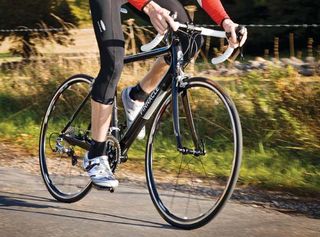
As we head towards the magic $1,000 mark, all bets are off. The dedicated bargain hunter can find almost any product in this price range, including carbon-fibre frames.
Be careful with carbon bikes sub-$1k, though — there are some good composite frames available, but there are also some shockers. Conversely, aluminium bikes at this price can be extraordinarily good, and may also come fitted with mid to upper-range gears and brakes. There is also a growing trend among manufacturers to fit mechanical disc brakes at this price point, too.
We’d recommend you really do your homework and read our tests. It’s not a case of general product quality — at this area of the market most bikes are very decent. However, there is the matter of specialisation. By the £1,000 point manufacturers have started to tailor their bikes to fulfil certain specific abilities. So whether you want an all-day comfort machine, or a speedy rocketship, almost any requirements can be filled. Just make sure you know what you want and pick wisely.
What to look for in a road bike between $750 and $1,000…
- A total weight of 9kg or possibly less
- A degree of model specialisation for particular ride criteria
- A top-quality aluminium frame with details such as internal cable routing, general tube manipulation, specific elements designed for comfort, strengthened bottom bracket for power delivery, tapered head tube for better handling
- Possibly even low-end carbon-fibre frame from specialist value brands (but be discerning when it comes to value carbon!)
- Mainly Shimano Tiagraor105components, although the occasional piece of super-plush Shimano Ultegra also appears. SRAM Apex or Rival, and even Campagnolo Veloce have also been spotted below £1,000
- Matching groupset caliper brakes or mechanical disc brakes
- Lighter, own-brand wheels or respected third-party wheelsets
- Mainly own-brand bar, stem and saddle — occasionally a third-party saddle
- Carbon fork
Get The Leadout Newsletter
The latest race content, interviews, features, reviews and expert buying guides, direct to your inbox!
Michelle Arthurs-Brennan the Editor of Cycling Weekly website. An NCTJ qualified traditional journalist by trade, Michelle began her career working for local newspapers. She's worked within the cycling industry since 2012, and joined the Cycling Weekly team in 2017, having previously been Editor at Total Women's Cycling. Prior to welcoming her daughter in 2022, Michelle raced on the road, track, and in time trials, and still rides as much as she can - albeit a fair proportion indoors, for now.
-
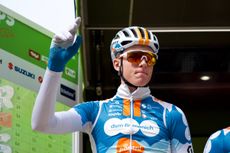 'It's a surreal experience' - Meet the British teenager racing with his heroes
'It's a surreal experience' - Meet the British teenager racing with his heroesOli Peace is stepping up in his first pro race at the Tour of the Alps
By Tom Davidson Published
-
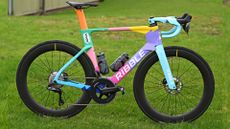 A closer look at the 'disruptive' Ribble Rebellion crit bike: part artwork, part race machine
A closer look at the 'disruptive' Ribble Rebellion crit bike: part artwork, part race machineThe Ribble Rebellion team is riding an eye-catching bike for 2024, in more ways than one
By Joe Baker Published
-
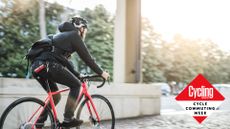 All the essentials to get started commuting by bike (on a budget – or not)
All the essentials to get started commuting by bike (on a budget – or not)Here is everything you need to buy for cycling to work – and how not to break the bank by doing so
By Stefan Abram Published
-
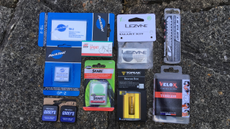 Best puncture repair kits 2024: Don’t waste tubes! Help your wallet and the environment
Best puncture repair kits 2024: Don’t waste tubes! Help your wallet and the environmentGet back on the road as easily as possible with our pick of the best puncture repair kits
By Paul Norman Last updated
-
 Best budget gravel bikes 2024: get off the beaten track without spending the earth
Best budget gravel bikes 2024: get off the beaten track without spending the earthThese budget gravel bikes allow you to enjoy off-road trails and explore new places without breaking the bank
By Katherine Moore Last updated
-
 Best budget sunglasses 2024: rated and reviewed
Best budget sunglasses 2024: rated and reviewedWe put low cost, good value sunglasses to the test
By Tom Epton Last updated
-
 The best budget bibshorts for cycling 2024: ridden and rated
The best budget bibshorts for cycling 2024: ridden and ratedHere are our top picks of the best low-cost bib shorts currently on the market
By Tom Epton Last updated
-
 Best budget women's bib shorts 2024 – comfort without the cost
Best budget women's bib shorts 2024 – comfort without the costA good set of cycling bib shorts doesn't need to be an expensive investment. Here's our thoughts after reviewing some of the cheaper and more affordable women's bibs.
By Rachel Sokal Published
-
 How do I get started in cycling on a budget?
How do I get started in cycling on a budget?We take you through the essentials you need and offer some top-value suggestions
By Luke Friend Published
-
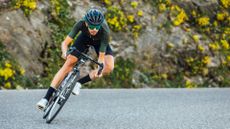 We took nine cheap road tyres to a rolling resistance testing facility and this is how they stacked up
We took nine cheap road tyres to a rolling resistance testing facility and this is how they stacked upHere nine budget tyres are through their paces - including a trip to Silverstone Sports Engineering Hub to test their rolling resistance
By Luke Friend Last updated